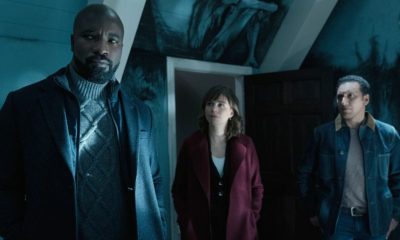Entertainment
The greatest part of ‘Foe’ is how the world is ending

Garth Davis’ dystopian sci-fi, Foe, has been getting some lukewarm reviews. But there’s one surefire element of the film, based on Iain Reid’s 2018 novel, that actually deserves its moment in the burning, burning sun — and it’s not necessarily the beautiful people feeling all the feelings within it.
It’s the way the world as we’ve known it is actually ending, often incrementally but surely. And you’d better believe it’s all thanks to climate change.
How is the world ending in Foe?
Set in the year 2065, Foe is a work of speculative fiction that presents an Earth that has become almost but not entirely inhospitable, when fresh water and inhabitable land are scarce. They’re not human rights but instead the most important capital a human being can own. It’s Mad Max without the steampunk or gang violence.
Reid’s novel keeps specifics of the apocalypse off the page, but the film, which Reid and Davis co-wrote, gives details at the top. In this version of America, the government’s Federal Climate Alert System has become useless. Human displacement sits at the centre of the global climate crisis, with nations uprooted by extreme weather events. Air quality has declined and respiratory conditions have risen. People are encouraged to stay indoors to avoid the extreme heat. Folks live off-grid if they can, using solar panels and reusing their waste water, but it’s all a little too late. At the core of the narrative, humanoid AI robot substitutes have replaced human labour in many industries.
Quietly surviving on a barren, isolated Midwest property is married couple Hen and Junior, played by Saoirse Ronan and Paul Mescal. In this future, inhabitable land is mainly owned by businesses or governments and used for farming; as for the rest, inheritance rules, as Junior’s property is fifth generation-owned. Above the dusty, cracked earth of the property, extreme weather events from intense dust storms to extreme heat are an everyday occurrence. Only one tree survives on the land, kept alive by the couple’s waste water. In fact, water is such a precious commodity that we regularly see Junior and Hen drinking cans of beer instead of water first thing in the morning — perhaps beyond mild hydration, beer doesn’t hurt for dealing with the end of the world, either. Though for someone trying to conserve water, Hen sure has some lengthy shower cries.

Credit: Amazon Studios
Foe shows the end of the world in an isolated, domestic silence for two people, but it’s also not quite ended. At every turn, it seems people are still working hard to keep surviving the harsh conditions. However, Junior and Hen’s quiet, rural life changes with the arrival of a man called Terrance (Aaron Pierre), who works for a government-backed company called OuterMore, wielding a plan to evacuate the planet — but notably slowly.
Plans to move people off-planet to a colossal space station near Earth are well underway, moving away from a “climate migration strategy” to simply getting the hell out of here. Terrance mentions that the moon, Mars, and other planets were possibilities built for the “first wave of temporary settlement”, but due to their distance from Earth and the time it will take to go back and forth to build a new colony there, OuterMore has instead built an enormous planet of its own near Earth and readies humans for permanent relocation to space through years of training.

Credit: Amazon Studios
People are chosen randomly through a lottery to participate in the first phase of the space program, known as The Installation, a two-year placement on the station to test its readiness for a whole planet to live on — but Terrance notes Junior’s physical strength as a positive attribute for it. Notably, the program isn’t optional for those chosen, instead functioning as a form of “fortunate conscription”. Through discussions of this station around Junior and Hen’s dining room table, Foe lightly takes aim at the billionaire space race and billion-dollar plans to terraform other planets like Mars. “Why should you be spending money up there when you should be fixing things down here?” Hen asks.
Hollywood disaster films love to cut to the chase.
By no means is Foe the only film to predict the end of the world through climate change and eventual human relocation to space — even in recent years, we’ve seen the likes of 2016 sci-fi Passengers sharing similar scenarios. But it’s something films have only started to really hammer home within the last few decades, with a notable rise in the 2000s. Though scientists had been warning of the coming threat for frustrating decades, and weather disaster films had long rampaged through cinemas, filmmakers finally seemed to harness these legitimate fears in the 2000s and 2010s, punishing earthlings’ blatant disregard for the planet with brutal, extreme weather-driven consequences in films like The Day After Tomorrow, Geostorm, 2012, and the Keanu Reeves remake of The Day the Earth Stood Still.
Not simply allowing viruses and sentient machines to destroy the world as we know it, rising sea levels caused by a warming planet finally got their moment in the 2000s, notably with Steven Spielberg’s 2001 film A.I. Artificial Intelligence — also aligned with Foe in terms of AI human replacements and self-aware robots in the coming apocalypse. In the film, set in the 22nd century, melting Arctic ice causes catastrophic flooding in coastal cities, meaning widespread human displacement, starvation, and death. New York is underwater. The global population plummets and humanoid robots step in for both human labour and companionship because they’re “never hungry and … did not consume resources beyond those of their first manufacture.”
In the book Hollywood Wants to Kill You, Rick Edwards and Dr. Michael Brooks write of Hollywood’s tendency to speed things up when it comes to planetary death by climate change, to get to the dramatically perilous stuff overnight instead of showing how it happens and how we could have stopped it gradually. The authors particularly skewer the films Geostorm and The Day After Tomorrow, which predict an overnight climate overhaul, a catastrophic tipping point that sees the planet plunged into every kind of extreme weather Hollywood can conjure at once.
“It turns out that governments, both Hollywood-imagined and real-life, aren’t really interested in long-term gains that involve short-term pain,” Edwards and Brooks write. The film 2012 also does this, cutting straight to the chase, but at least the movie consistently reiterates that scientists and world leaders have known what’s coming for years.
But one of the most realistic parts of the potential end of the world in Foe is not that we’ll all inevitably shack up with a smokin’ partner with an endless supply of PBRs. It’s that some things will happen slowly, the decline of the planet’s habitable spaces slowly increasing as CO2 levels skyrocket, climate science misinformation continues, and government inaction prevails. (Some impacts, like amplified Western U.S. wildfires and increased flooding, are happening rapidly.)
Foe isn’t a perfect representation of a future Earth, notably being the experience of two sad yet socioeconomically advantaged white people, citizens who by no means are on the frontline of the climate crisis. And notably, climate doomism itself gets us nowhere — we’re not completely up the bone dry creek yet. Despite how things appear, we haven’t passed a point of no return, and earthlings still have the power to either exacerbate the planet’s problems or seal them in stone.
Instead, Foe is a cautionary tale, a hypothetical endgame. One that’s slow but sure, and without action on climate change, could very well be what the end of the Earth looks like.
How to watch: Foe is now in theaters and will be streaming on Prime Video at a later date.
-

 Business6 days ago
Business6 days agoCheckfirst raises $1.5M pre-seed, applying AI to remote inspections and audits
-

 Business5 days ago
Business5 days agoAI chip startup DEEPX secures $80M Series C at a $529M valuation
-

 Entertainment4 days ago
Entertainment4 days agoJinkx Monsoon promises ‘the queerest season of ‘Doctor Who’ you’ve ever seen!’
-

 Business4 days ago
Business4 days agoStrictlyVC London welcomes Phoenix Court and WEX
-

 Business5 days ago
Business5 days agoRetell AI lets businesses build ‘voice agents’ to answer phone calls
-

 Entertainment4 days ago
Entertainment4 days ago'House of the Dragon' recap: Every death, ranked by gruesomeness
-

 Entertainment6 days ago
Entertainment6 days ago8 reasons ‘Evil’ is the greatest show you’re not watching
-

 Entertainment6 days ago
Entertainment6 days agoSlutshaming on the internet: Read an extract from ‘Sluts’ by Beth Ashley



























